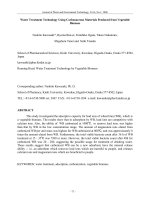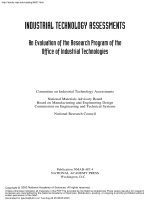- Trang chủ >>
- Khoa Học Tự Nhiên >>
- Vật lý
ACCELERATED MD PROGRAM USING CUDA TECHNOLOGY
Bạn đang xem bản rút gọn của tài liệu. Xem và tải ngay bản đầy đủ của tài liệu tại đây (241.49 KB, 5 trang )
Proc. Natl. Conf. Theor. Phys. 35 (2010), pp. 197-201
ACCELERATED MD PROGRAM USING CUDA TECHNOLOGY
HOANG VAN HUE
Tay Nguyen University, 567 Le Duan, Buon Ma Thuot, Daklak
NGUYEN THI THANH HA, PHAM KHAC HUNG
Department of Computational Physics, Hanoi University of Science and Technology,
1 Dai Co Viet, Hanoi
Abstract. Molecular dynamic (MD) simulation is proven to be an important tool to study the
structure as well as the physical properties at atomic level in material science. However, it requires
a huge computing time and hence limits the ability to treat a large scale simulation. In this paper
we present a solution to speed up the MD simulation using CUDA technology (Compute Unified
Device Architecture). We used the GeForce GTS 250 card with Version 2.30. The simulation is
implemented for Lennard-Jones systems with periodic boundary conditions which consist of 1024,
2048, 4096 and 8192 atoms. The calculation shows that the computing time depending on the
size of system and the number of time step could be decreased to 37 times. This result indicates a
possibility of constructing a large MD model up to with 105 atoms on the usual PC.
I. INTRODUCTION
Molecular dynamics (MD) simulation is one of the important tools widely used to
study the structure as well as the dynamic behavior of materials at atomic level. However,
it consumes much computing time that limits the ability to treat a large scale simulation
[1, 2, 3, 4, 5, 6]. For example, to construct a MD model SiO2 LiO2 of the 3000 atoms on
the PC takes about 60 hours. Hence, the solution to speed up computing process is of
great interest for researchers in the field of MD simulation.
CUDA technology is one among approaches to resolve the problem just mentioned
[7]. It is an developing platform designed for general-purpose applications, which allow
manage the computations on the GPU (Graphics Processing Units) as a data-parallel computing device without the need of mapping them to a graphics API (application programming interface). GPU have many processing cores (processors) to perform computing,
each grouped into multiprocessors. There are several levels of memory which differs in
terms of access speed and scope: the registers have processor scope; the Shared Memory,
Constant Cache and Texture Cache have multiprocessor scope and the Device (or Global)
memory can be accessed by all cores on a chip [7]. The computation can be accelerated
by data-parallel processing method of hundred of processors. According to the authors
in ref. [2] the computing performance of MD simulation can be increased by 3.5 times.
Later works shows the effectiveness of GPU computing reached 10-20 [3], 19 [4] or 24 times
[5], even up to 100 times [6]. Recently, as noted in [5], with fast development of GPU
technology there are many new possibilities in application of GPU computing in the field
of scientific research, especially for MD simulations. On the other hand, the cost of GPU
cards is relatively small and consistent with final possibility of many labs in Vietnam. In
198
HOANG VAN HUE, NGUYEN THI THANH HA, PHAM KHAC HUNG
comparison with super computer the PCs with GPU cards could provide the similar computing environment for many scientific problems, although the cost of those computing
systems is significantly different. Therefore, the study of applying the computing on PC
with GPU is of great interest from both scientific and practical points of view. In this
paper, we present the MD program running on GeForce GTS 250 Card and the simulation
result of MD models consisting of 1024, 2048, 4096 and 8192 atoms.
The rest of present paper is organized as follows: in section 2 we describe the
calculation method included the Molecular dynamic program and the algorithm based on
CUDA computing. The section 3 concerns the simulation result and discussion.
II. CALCULATION METHOD
II.1. Molecular dynamic method
Initial configuration of MD model is constructed by random placing all particles in
simulation box such that they do not collide. Then the interaction force exerted on each
particle by remained particles is calculated. The forces are used to calculate the velocity
of each particle and a new distribution of particles is obtained by Newtonian equation of
motion. Usually, the potential energy is calculated as a sum of the interaction between
every two particles, e.g. the pair interaction potential is employed depending only on the
distance between two particles. After that, a new distribution of particles is generated and
then again a new one so that eventually a long sequence of distributions evolves. Consider
a system contains N atoms, and let all atoms interact with each other according to a pair
potential. The potential energy of system U is given as
U=
ϕ(rij ),
(1)
ij
here rij is a distance between the particles i and j. The ith particle feels a force
fi = −
U = mi ai ,
(2)
here mi is the atom mass, ai is its acceleration
In this paper, we simulate a system with the Lennard-Jones potential [1] which has
the form:
δ 6
δ 12
−
.
(3)
ϕ(rij ) = 4ε
rij
rij
The function (3) has a minimum with value −ε. Usually, both e and d are chosen to
fit some physical properties of the material under consideration. The molecular dynamics
codes applied here can be found elsewhere [1, 2, 3, 4, 5, 6, 7, 8]. We apply a simple cube
box with periodic boundary conditions. At each time step, the force is calculated between
each pair of atoms within a cut-off distance taken to be a half of simulation box length.
The net force on each atom is used to determine a new position of particles in accordance
to New-tons equation of motion. The integration is performed using a velocity-Verlet
algorithm. No cell or neighbor lists were used. The other characteristics such as the pair
radial distribution function (PRDF) and dynamic parameters is determined by averaging
ACCELERATED MD PROGRAM USING CUDA TECHNOLOGY
199
over several last thousand steps in order to decrease the statistic error related to small
size of the model.
II.2. The algorithm of CUDA programming model
The new MD algorithm is designed using CUDA library on NVIDIA GPU and a set
of standard commands from NVIDIA codes [7]. Similar to graphics applications, CUDA
applications can be accelerated by data-parallel computation of millions of threads. This
is a main concept of CUDA parallel computing model. The threads must execute the
same function with different parameters. The function that contains the computations
and runs parallel in many instances is called the kernel. Threads in the same thread group
can synchronize with each other, by inserting synchronization points in the kernel, which
must be reached by all threads in the group before continuing execution. The threads
can also share data during execution. By this way, usually several hundred threads in the
same block can work cooperatively. Each blocks can contain anywhere from 32 to 512
threads, but all blocks must be the same size. Any number of blocks can be run on the
device, though optimum performance requires more than a hundred blocks executing in
parallel. Each block executes identical lines of code and is given an index starting from 0
to identify which is a piece of the data. Within each block, threads are numbered from 0
to identify the location of the thread within the block.
Our implementation of the molecular dynamics algorithm was developed for and
tested on Version 2.30, GeForce GTS 250 card. The algorithm consists of two blocks:
1/ To transfer the data from CPU to GPU for operating the parallel calculations
on GPU and to transfer the result back from GPU to CPU
2/ To performance the computing on 128 processors of GPU.
The efficiency of the algorithm depends on both blocks. Such the computing time
must consume much less than that the memory transferring in the second block has spent.
A Cuda program is composed of two parts: a host (CPU) code that makes kernel
calls, and a device (GPU) code that actually implements the kernel. The host code is
conceptually a serial C program, but the device code should be massively parallel in order
to harness the power of the GPU. In our program the force calculation and the atomic
movement have been operated on GPU. The remaining works is performed on CPU as
in the case of MD program for CPU. Note that the speed of parallel computing on the
GPU significantly depends on how divide the computing task between the processors and
also to use the local memory of GPU. After intensive treating a number of possible ways
of parallel computing and memory map we found that the computing speed for different
ways may reach a difference in 10 times.
III. DISCUSSION AND CONCLUSION
Firstly we test the validity of our new MD program by comparing the PRDF obtained from both programs. Fig.1 shows the PRDFs for two MD models constructed by
both MD programs. One can see that they are identical indicating the correct computing
result of new MD program. To evaluate the efficiency of new MD program we use two
quantities:
200
HOANG VAN HUE, NGUYEN THI THANH HA, PHAM KHAC HUNG
1/ the speed-up factor determined as the ratio of computing speed of new and former
programs;
2/ the real runtime.
Fig. 1. The radial distribution function running GPU and CPU.
Fig.2 (left) shows the results of our MD simulation under different sizes of simulation
box (number of atoms). The speed-up factor and runtime are presented as a function
of model size. As the number of atoms varies from 1000 to 4000, the speed-up factor
increases, but the speed-up factor remains unchanged with further increasing model size.
The maximal value of speed-up factor is about 37 times.
Fig. 2. The dependence of the speedup- factor (a) and runtime (b) on the number
of atoms (left) and the dependence of the speedup-factor (a) and runtime (b) on
the number of time steps (right).
Fig.2 (right) presents the result of dependence of GPU efficiency on the number of
time step. We again observe the similar trend as in the case of model size. The GPU
ACCELERATED MD PROGRAM USING CUDA TECHNOLOGY
201
efficiency may reaches 36 times when the MD simulation runs up to 6000. After running
up over 8000 steps the averaged runtime per one step is 5 and 0.9 seconds for CPU and
GPU MD programs respectively.
Such, our simulation shows that the MD program running on on GeForce GTS
250 Card allows speed up to 37 times. It opens a new possibility to make a large scale
simulation. For example, to construct a MD model of iron liquid of 5000 atoms consumes
about 30 hours on usual PC. Using a new MD program the model of 105 iron atoms can
be prepared over about the same times on the same PC with GeForce GTS 250 Card.
REFERENCES
[1] F. H. Stillinger, D. K. Stillinger, Mechanics of Materials 38 (2006) 958.
[2] M. C. Schatz, C. Trapnell, A. L. Delcher, A. Varshney, BMC Bio informatics 8 (2007) 474.
[3] Daniel Castao-Dez, Dominik Moser, Andreas Schoenegger, Sabine Pruggnaller, Achilleas S. Frangakis,
Journal of Structural Biology 164 (2008) 153.
[4] Weiguo Liu, Bertil Schmidt, Gerrit Voss, Wolfgang Mller-Wittig, Computer Physics Communications
179 (2008) 634.
[5] Yusuke Okitsu, Fumihiko Ino, Kenichi Hagihara, Parallel Computing 36 (2010) 129.
[6] F. Molnar et al., Computer Physics Communications 181 (2010) 105.
[7] See, NVIDIA CUDA Programming Guide, develop.html.
[8] S. Plimpton, Journal of Computational Physics 117 (1995) 1.
Received 10-10-2010.









